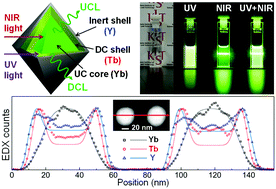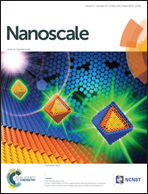Direct observation of the core/double-shell architecture of intense dual-mode luminescent tetragonal bipyramidal nanophosphors†
Abstract
Highly efficient downconversion (DC) green-emitting LiYF4:Ce,Tb nanophosphors have been synthesized for bright dual-mode upconversion (UC) and DC green-emitting core/double-shell (C/D-S) nanophosphors—Li(Gd,Y)F4:Yb(18%),Er(2%)/LiYF4:Ce(15%),Tb(15%)/LiYF4—and the C/D-S structure has been proved by extensive scanning transmission electron microscopy (STEM) analysis. Colloidal LiYF4:Ce,Tb nanophosphors with a tetragonal bipyramidal shape are synthesized for the first time and they show intense DC green light via energy transfer from Ce3+ to Tb3+ under illumination with ultraviolet (UV) light. The LiYF4:Ce,Tb nanophosphors show 65 times higher photoluminescence intensity than LiYF4:Tb nanophosphors under illumination with UV light and the LiYF4:Ce,Tb is adapted into a luminescent shell of the tetragonal bipyramidal C/D-S nanophosphors. The formation of the DC shell on the core significantly enhances UC luminescence from the UC core under irradiation of near infrared light and concurrently generates DC luminescence from the core/shell nanophosphors under UV light. Coating with an inert inorganic shell further enhances the UC–DC dual-mode luminescence by suppressing the surface quenching effect. The C/D-S nanophosphors show 3.8% UC quantum efficiency (QE) at 239 W cm−2 and 73.0 ± 0.1% DC QE. The designed C/D-S architecture in tetragonal bipyramidal nanophosphors is rigorously verified by an energy dispersive X-ray spectroscopy (EDX) analysis, with the assistance of line profile simulation, using an aberration-corrected scanning transmission electron microscope equipped with a high-efficiency EDX. The feasibility of these C/D-S nanophosphors for transparent display devices is also considered.


 Please wait while we load your content...
Please wait while we load your content...